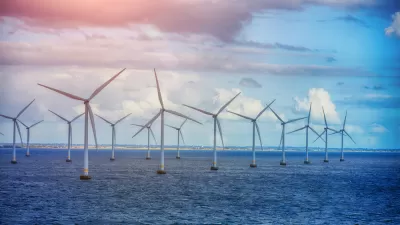If a Seattle company gets its way, in a few years there will be 100 floating wind turbines about 15 miles off San Luis Obispo County on the central California coast, generating about 1 gigawatt of electricity.
The Trident Winds Offshore Wind Energy Project would be a "first" in at least two important ways: The first offshore wind project on the West Coast, and the first floating wind farm in the U.S.

Credit: San Jose Mercury News
"Most offshore wind turbines around the world are fixed to the ocean bottom, usually with foundations held down by steel pilings to withstand huge waves and gale-force winds," writes Paul Rogers, science and environment reporter for the San Jose Mercury News. "Floating turbines are easier to install and less intrusive, supporters say."
A major benefit of the project is that it converts a fossil fuel albatross, a mothballed power plant into a producer of renewable energy.
The 100 turbines would be spaced about half a mile apart, covering 40,000 acres of ocean and linked together with underwater power cables. The electricity would be shipped through one power line buried in the ocean floor back to the Morro Bay Power Plant, a former PG&E facility that was shuttered in 2013 but is still connected to existing transmission lines.
One compelling reason to approve the project, as well as other large renewable projects in California, is legislation (SB 350) requiring California to produce half its electricity from renewable sources in 15 years.
The biggest hurdle facing the project, as with other offshore wind farms, may be the aesthetics—the impact on the coastal "viewshed." Rogers has quotes from many environmental groups, some in support, some more cautious. His interviews comprise one of the most interesting parts of the article.
One of the more telling interviews is with a Santa Barbara group. Some say that it was in Santa Barbara that "the modern environmental movement was born in 1969, with a 4-million-gallon oil spill." Readers may recall the 100,000 gallon oil spill along the Santa Barbara coast from a pipeline rupture in May.
It sounds really, really horrible. This is a fairly massive project," said Susan Jordan, director of the California Coastal Protection Network in Santa Barbara. "California places a great deal of value on the Pacific coastline and what it looks like when you travel there. People don't want to look out and see a floating industrial facility."
Other floating wind farms:
"There are three floating turbines off the coast of Japan and one off Norway," and Scotland will also have five large turbines to be built by Statoil, a Norwegian oil and gas company, expected to begin producing energy in 2017, writes Rogers.
A proposed offshore wind farm project near Coos Bay, Oregon, also using floating turbines, does not appear to be going forward according to Breaking Energy last June.
FULL STORY: California's first offshore wind farm proposed near Hearst Castle

Planetizen Federal Action Tracker
A weekly monitor of how Trump’s orders and actions are impacting planners and planning in America.

Congressman Proposes Bill to Rename DC Metro “Trump Train”
The Make Autorail Great Again Act would withhold federal funding to the system until the Washington Metropolitan Area Transit Authority (WMATA), rebrands as the Washington Metropolitan Authority for Greater Access (WMAGA).

DARTSpace Platform Streamlines Dallas TOD Application Process
The Dallas transit agency hopes a shorter permitting timeline will boost transit-oriented development around rail stations.

Renters Now Outnumber Homeowners in Over 200 US Suburbs
High housing costs in city centers and the new-found flexibility offered by remote work are pushing more renters to suburban areas.

The Tiny, Adorable $7,000 Car Turning Japan Onto EVs
The single seat Mibot charges from a regular plug as quickly as an iPad, and is about half the price of an average EV.

Supreme Court Ruling in Pipeline Case Guts Federal Environmental Law
The decision limits the scope of a federal law that mandates extensive environmental impact reviews of energy, infrastructure, and transportation projects.
Urban Design for Planners 1: Software Tools
This six-course series explores essential urban design concepts using open source software and equips planners with the tools they need to participate fully in the urban design process.
Planning for Universal Design
Learn the tools for implementing Universal Design in planning regulations.
Municipality of Princeton
Roanoke Valley-Alleghany Regional Commission
City of Mt Shasta
City of Camden Redevelopment Agency
City of Astoria
Transportation Research & Education Center (TREC) at Portland State University
US High Speed Rail Association
City of Camden Redevelopment Agency
Municipality of Princeton (NJ)



























